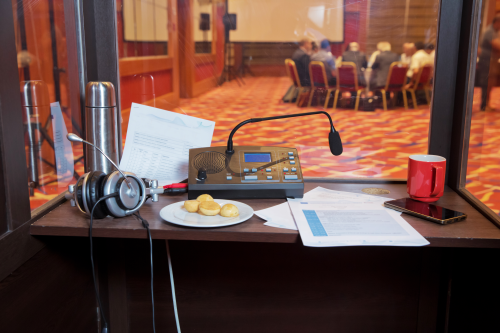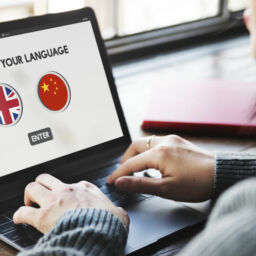
In a fast-moving, interconnected world, you may often find yourself in need of the services of a translator or an interpreter. Despite great progress in language processing technologies, those specialists are still often irreplaceable. Especially when something needs to be simultaneously translated.
What is simultaneous translation? When is it most useful, and when may it not be the best choice? Who is an interpreter? And why should you even care? In this article, we give you the answers to all of these questions and more.
A quick disclaimer before we move on: throughout the text, we use translation and interpretation interchangeably, even though formally in the field of translation studies, the former refers to written renditions and the latter to spoken ones. We feel, however, that the term ‘translation’ will be more clear for a general audience.
Contents
What is the meaning of simultaneous translation?
When something is simultaneously translated, the message in the target language is being conveyed practically at the same time as in the source language. Everything happens simultaneously. The translation is usually only a few words behind the original speaker. This way the target audience can follow the dialogue, conversation or speech as it happens. But it does demand quite a lot of preparation, both on the side of interpreters and organisers.



What does it look like?
In a normal environment, it would be virtually impossible to translate simultaneously because two people would be speaking at the same time in two different languages. No one would be able to hear anything and the results would be disastrous.
That’s why a range of electronic equipment is of assistance during such work. The interpreters are seated in a soundproof booth, usually in pairs. When one speaks, the second one can assist him with notes or take over in case the first one loses the flow of the conversation. They are equipped with headphones and microphones, and only hear what the speaker is saying. In real-time, the interpreter translates the speech and broadcasts it through the microphone. Members of the audience have their own headphones connected to a booth of the interpreter of the language they can understand. Today, the translation is transmitted wirelessly.
A simultaneous interpreter has to do multiple things at the same time, and do them fast. The whole process includes listening to words spoken in as source language; comprehending them, performing semantic analysis and operations and transformation on information retained in short-term memory, and generating speech in the target language; all of that while paying attention to what they are saying in order to catch any mistakes. They also, to a point, need to predict what the speaker will say next as if continuously solving crossword clue after clue. The work is tremendously demanding, and even experienced professional translators work in 30-minute shifts during which they can translate more than 4500 words.



What does it take to be an interpreter?
All of that requires immense skill. You not only need to have an excellent command of a source language, but also be able to think on your feet, while speaking to a large body of people. Sometimes the source speaker has a thick accent or speaks about current events, which the translator might not have known about. The interpreter listens to all of that and in mere seconds needs to transfer that simultaneously translated message to the target listener.
Skills other than great linguistic competence, that aspiring translators should possess, include extensive knowledge about culture, customs, history, and political affairs that connect with the language that they translate into.
The simultaneous translation is taught as either a Master’s degree or a postgraduate course, and the education lasts minimum two years.
Is there a demand for simultaneous translation?
Because of the difficulty of the job, there aren’t that many simultaneous interpreters, which makes the demand for their services quite high. They can find employment in government institutions or multinational organisations such as European Union, United Nations, and others. Alternatively, they can find employment in a translation agency or as freelancers and work in the private sector interpreting conferences, for example. Interpreters are also needed in the judicial, medical and military sectors.
The history behind simultaneous translation/interpretation
Simultaneous interpretation is a relatively young form of translation. The technology for simultaneous translation equipment was developed and patented in 1926 by IMB employee Alan Gordon Finlay. However, it hadn’t found widespread use before the Nuremberg trials that were held after the Second World War.
The trials were the first major simultaneously translated event. Court proceedings were to employ four languages: English, French, German and Russian. Due to the extensive amount of testimonies that needed to be translated, consecutive interpretation was deemed unfit as it would slow down the process, and it was decided to introduce an entirely new technique – simultaneous interpretation. Some people who had been recruited for the task already had experience in translation or linguistics; others were army personnel or even fresh school graduates that spoke the required language.
Although it was a great challenge for them and errors were unavoidable, it is believed that the simultaneously translated testimonies were vital, and without this new method, the trials wouldn’t have been possible.



Advantages of a good simultaneous translation
Foremost, just like any translation, it allows for bridging the language barrier. Compared to consecutive translation, simultaneous is also more time efficient as it occurs literally as the message is being conveyed, and doesn’t disrupt the speaker’s flow. Furthermore, the speech can be translated into any number of languages at the same time. All of that allows for ensuring accurate and effective communication between a source speaker and listeners.
Just remember to hire reputable, experienced, professional interpreters who will deliver an easily understandable well-paced translation that is free of mistakes.
When should simultaneous translation be considered?
A lot of effort and resources are needed to organise a simultaneously translated event. This is why it may not be the best fit for translating, for instance, a business meeting of only two parties. Instead, it will be better suited for conferences or conventions with many attendees from different parts of the world, who do not share a common language. If that isn’t the case for you, it may be wiser to take other forms of translation and interpretation into account.
Alternatives to consider
Consecutive translation still isn’t obsolete, and it requires less effort, although is more time-consuming. In this mode of interpretation, the translator communicates after a few sentences or when the speaker has finished, depending on the length of the message.
Whispered interpreting or chuchotage is a different form of simultaneous translation that doesn’t depend on electronic equipment. However, it allows for only one recipient of the interpretation. The interpreter sits next to the person who doesn’t speak the language and delivers a translation by speaking into their ear.
If the message was prepared beforehand, it can also be translated and presented on the spot by an interpreter, just as he reads it. Of course, it is always better to have some time to prepare, but sometimes it just isn’t possible.
Translation is what we do best
So now you have the answer to the question of what ‘simultaneously translated’ means and the basics of how it works and came to be. Also, you should have a better idea of how many skills interpreters have to master to be able to translate speech in an instant.
We hope you found this article interesting. Want to learn about translation? Let us know! And if you are in need of one, look no further. We specialise in all manner of translations, written ones, interpreting, software localisation, and more. If you would like to learn more about foreign languages, consider attending one of our language courses. We provide services for companies as well as private individuals. Detailed information about our offer can be found on our website.















